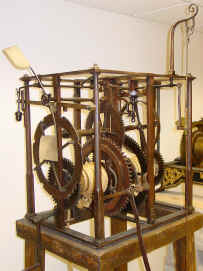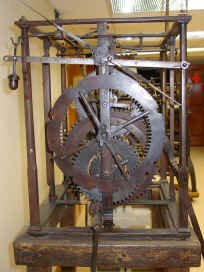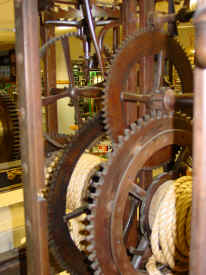DUTCH, MAKER UNKNOWN, C.1670'S
An old example from Holland. Two train, original Huygens configured horizontal crown wheel /verge escapement. End-to-end birdcage, forged iron frame. Corner posts held by nuts, the balance of the frame secured by wedges. Winding drums replaced in the past, remainder of clock and possibly wood stand original. 24"w x 24"h x 18"d.
Note the difference in the quality of construction between this and the Bavarian clock even though this predates it by almost 100 years. The horizontal crown wheel is the original configuration used by Chistiaan Huygens when he first applied the use of a pendulum to regulate clock works. Prior to this mechanical clocks used a T-bar shaped device called a foliot in conjunction with a vertical crown wheel see (Italian Iron Chamber Clock in the skeleton clock section). The invention of the anchor escapement around 1680, made the verge escapement obsolete. In tower clocks that had the vertical crown wheel /verge arrangement, it was a relatively easy process to substitute the new anchor escape wheel for the the vertical crown wheel so most clocks had their foliot escapements replaced. The process is not so straight forward in a clock equipped with a horizontal crown wheel as this one is. Perhaps this is what saved this clocks' original escapement. It may have been replaced rather than reworked.







